![]()
![]()
![]()
Use LEFT and RIGHT arrow keys to navigate between flashcards;
Use UP and DOWN arrow keys to flip the card;
H to show hint;
A reads text to speech;
28 Cards in this Set
- Front
- Back
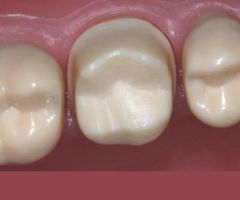
For a gold crown CVC prep, the shoulder should measure _____ mm prior to beveling? |
0.65 - 1.0 mm |
|
|
How can you verify occlusal reduction? |

You can verify with a 13 hatchet. The 13 hatchet should fit snugly when inserted at a cuspal angle. |
|
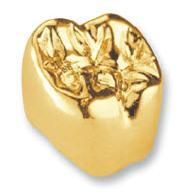
Which type # of casting gold alloys is used to make gold crowns? |
Type III is used to make onlays & gold crowns. More gold = less strength. From weakest to strongest. Type I: Has more gold. Small inlays. Type II: Inlays. Type III: 70-75% Au; onlays & gold crowns. Type IV: Has less gold. cast post in endodontic treated tooth & gold RPD framework. |
|
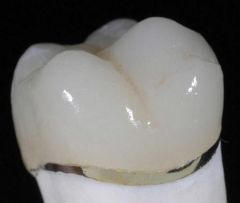
What are the characteristics of porcelain? |
Porcelain is - strong in compressive strength. - weak in tensile & shear strength. Therefore, it needs to be supported. |
|
|
What are ceramics? |
Ceramics are inorganic compounds with both metallic + non-metallic elements... however, they have non-metallic properties. |
|
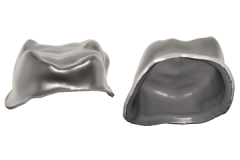
What is a metal coping? |
A metal coping is a metal cap which is applied over a prepared tooth. It can be used to support porcelain. The metal collar is part of the coping and prevents it from flexing (provides rigidity). |
|

PFMs can be sintered. What is sintering? |
Sintering is a process that involves heating closely packed particles to a specified T below the MP of the main component, to densify and strengthen a structure as a result of bonding, diffusion, and flow phenomena. |
|
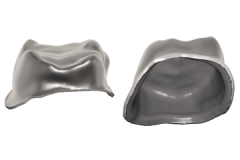
What can the metal coping be made of? |
A. Noble alloys (excludes silver, Ag): - high-gold alloys: resembles dentin when viewed through porcelain - low-gold alloys - palladium-silver - high palladium (opaque porcelain is used to mask the dark oxide in low-gold and palladium alloys) B. Base Metal alloys: >75% base metal or <25% noble metal - nickel-chromium alloys - chromium-cobalt alloys - titanium alloys |
|
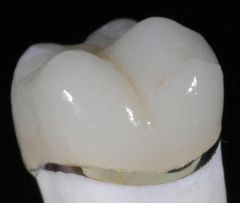
What can trace elements be used for in a PFM? |
Trace elements: indium (In), Zinc (Zn), Tin (Sn) are used to create an oxide layer on metal to bond with porcelain. |
|
|
Holding the bur parallel to the POI during theprep will create a _____ convergence anglebetween the walls. |
6º |
|
|
Occlusal reduction should be _____ mm ideally. |
1.5 mm (range: 1.0 - 1.75 mm) |
|
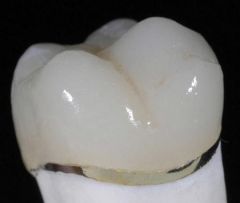
What are the primary purposes of the metal coping and porcelain within a PFM? |
Metal coping grants strength. Porcelain grants esthetics. |
|
|
Name some methods to strengthen porcelain. |
Use internal coping for support: - metal (PFM) - high strength ceramics (all ceramic crowns) Improve strength of outer porcelain surface - glazing |
|
|
What are we referring to when we talk about the thermal compatibility of metal ceramics? Which has a higher thermal CoE? Metal or porcelain? |
We are talking about the ability of a metal and its veneering porcelain to contract at similar rates during cooling from the ceramic sintering T. Metal > porcelain (slightly). |
|
|
How thick should the metal coping be? The porcelain? |
Metal coping = 0.3 mm Porcelain = 1.0 mm - opaque porcelain: 0.2 mm - body porcelain - enamel porcelain |
|
|
Which one is stronger and supports porcelain better: circumferential (360) metal collar vs porcelain buccal/lingual metal collar? |
Circumferential (360) metal collar, because its metal collar extends all the way around. |
|
|
What are the advantages of using base metal alloys? Disadvantages? |
Base metal alloys Advantages - high strength - low weight & cost Disadvantages - shrinks easily (causes problems with fit) - thick oxide layer (makes it more difficult to bond to porcelain, solder) - nickel allergy (22% for women, 10% for men) - beryllium toxicity |
|
|
The higher the gold content, the _____ the metal coping must be. |
Thicker; to compensate for weakness. Minimum thickness for metal ceramic copings: - Hi-Au: 0.5 mm - Low-Au: 0.3 mm - Ag-Pd: 0.3 mm - Base metal: 0.1 mm |
|
|
A metal collar requires a _____ prep, while a porcelain labial/buccal margin requires a ____ prep. |
Metal collar: shoulder-bevel prep Porcelain labial/buccal margin: shoulder prep |
|
|
A shoulder bevel prep should follow _____. A shoulder butt joint prep should be _____. |
POI; 90 degrees to the root surface. |
|
|
A cutback is made to create room for porcelain. What are the purposes of a cutback? |
Purposes of cutback: - Provides proper support for porcelain - Provides for a uniform thickness of porcelain - Predictable esthetics - Allows porcelain to "wrap around" the metal framework and increases compressive bonding of porcelain. |
|
|
What does degassing the metal framework do? |
Degassing creates an oxide layer which helps establish a chemical bond between metal and porcelain. |
|
|
Explain the purpose of adding the 2 layers of opaque porcelain to the metal coping. |
1. A thin wash layer is applied in order to completely wet the metal to create the bondbetween porcelain and the oxide layer of the metal. The coping is dried and fired under vacuum. 2. A second application is then applied to mask the dark metal oxide color. This layer shouldbe as thin as possible, just thin enough to mask the metal. The opaque layershould be approx 0.1 mm thick. |
|
|
List the steps required to make a PFM. |
- Wax up (full contour) restoration - Cut back (to create room forporcelain) - Cast metal coping/framework - Oxidizing / Degas - Opaque porcelain addition/firing - Body & Incisal porcelainaddition/firing (2-3 firing) - Glazing/firing |
|
|
What are the 3 types of bonds that exist between porcelain and metal? |
Mechanical Bonding - Micro irregularities inmetal: grinding & airabrasion Chemical Bonding - Oxide layer: degasing Compression Bonding - Framework design - Thermal CoE |
|
|
Unlike a gold crown CVC prep, a PFM prep requires _____ mm of axial reduction, and _____ mm of occlusal reduction. |
ideal: 1.3 mm (range 1.0-1.5 mm); ideal: 2.0 mm (range: 1.5-2.5 mm) |
|
|
What instruments can you use to finish a porcelain labial margin? |
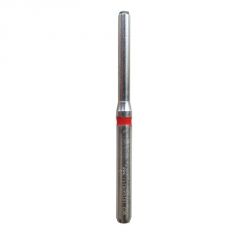
End cutting bur; 13 bin angle chisel. |
|
|
If the lingual metal collar is >1.5 mm tall, the axial reduction should be _____ mm. If the lingual metal collar is <1.5 mm tall, the axial reduction should be _____ mm. |
0.65 mm; 0.8 mm The shorter the metal collar is, the more axial reduction you need to support the porcelain on top. |

